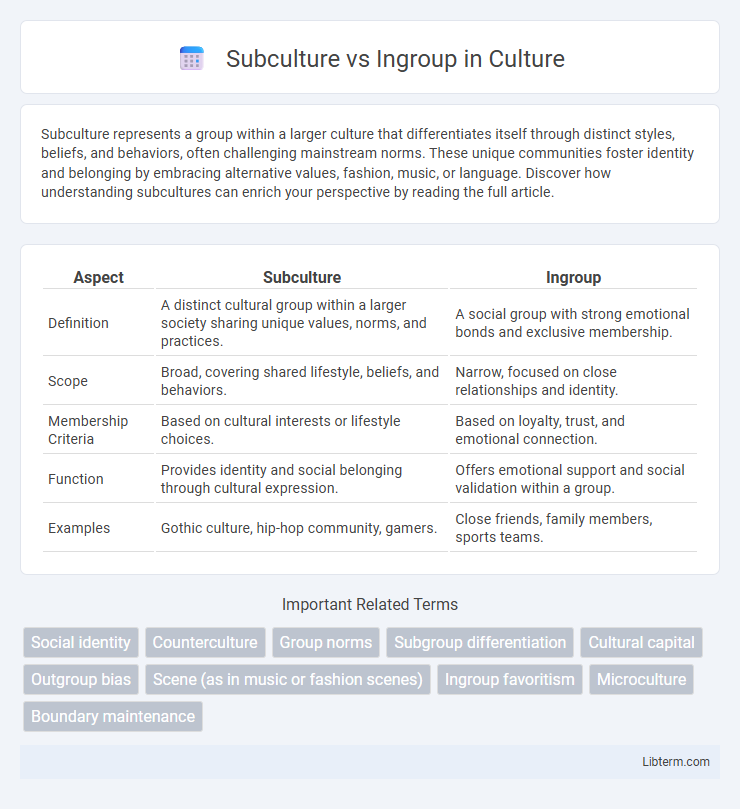Subculture represents a group within a larger culture that differentiates itself through distinct styles, beliefs, and behaviors, often challenging mainstream norms. These unique communities foster identity and belonging by embracing alternative values, fashion, music, or language. Discover how understanding subcultures can enrich your perspective by reading the full article.
Table of Comparison
| Aspect | Subculture | Ingroup |
|---|---|---|
| Definition | A distinct cultural group within a larger society sharing unique values, norms, and practices. | A social group with strong emotional bonds and exclusive membership. |
| Scope | Broad, covering shared lifestyle, beliefs, and behaviors. | Narrow, focused on close relationships and identity. |
| Membership Criteria | Based on cultural interests or lifestyle choices. | Based on loyalty, trust, and emotional connection. |
| Function | Provides identity and social belonging through cultural expression. | Offers emotional support and social validation within a group. |
| Examples | Gothic culture, hip-hop community, gamers. | Close friends, family members, sports teams. |
Defining Subculture: Key Characteristics
Subculture is defined by distinct values, norms, and symbols that differentiate its members from the broader society while maintaining overall societal coherence. Key characteristics include shared practices, language or slang, and unique styles that foster a strong sense of identity and community within the group. Unlike ingroups, which form around social bonds and common interests, subcultures emphasize cultural expression and often challenge mainstream conventions.
Understanding Ingroup Dynamics
Ingroup dynamics revolve around shared norms, values, and strong emotional bonds that create a cohesive social identity within a group. Subcultures, as distinct entities within larger societies, often exhibit unique behaviors and beliefs that reinforce ingroup solidarity and differentiate members from outsiders. Understanding these dynamics is crucial for analyzing how group loyalty, conformity, and social influence shape individual and collective actions.
Historical Origins of Subcultures
Subcultures trace their historical origins to early industrial societies where marginalized groups sought distinct identities through unique styles, behaviors, and values, often as forms of resistance or social differentiation. Unlike ingroups, which form based on shared social or familial bonds, subcultures develop around specific interests, ideologies, or lifestyles that diverge from mainstream culture. The emergence of subcultures such as punk, goth, or hip-hop highlights how historical contexts like economic hardship and urbanization shape collective expressions of identity and community.
Types of Ingroup Formations
Ingroup formations consist of various types such as primary groups, secondary groups, and reference groups, each serving distinct social functions and levels of emotional connection. Primary groups, like families and close friends, provide strong emotional support and identity, while secondary groups are larger and goal-oriented, such as workplaces or political organizations. Reference groups influence an individual's self-evaluation and behavior by providing standards and norms, playing a crucial role in social identity and group dynamics within subcultures.
Social Identity: Subcultures vs Ingroups
Subcultures form distinctive social identities within larger societies by sharing unique values, norms, and symbols that differentiate them from the mainstream culture. In contrast, ingroups highlight social identity through familiarity and emotional bonds among members who perceive themselves as part of a cohesive unit, often defined by exclusive membership and shared experiences. Both subcultures and ingroups play critical roles in shaping individual social identity and group dynamics.
Cultural Expression and Symbolism
Subcultures exhibit distinct cultural expressions and symbolism that differentiate them from the broader ingroup, using unique styles, language, and rituals to convey identity and values. These symbolic elements serve as a form of resistance or alternative perspectives within the dominant culture, reinforcing group cohesion and shared meaning. In contrast, ingroups maintain cultural expression through more mainstream or widely accepted symbols that promote unity and collective norms across the larger social group.
Influence on Behavior and Values
Subcultures shape behavior and values by creating distinct norms and practices that differentiate members from the larger society, influencing identity and social interactions. Ingroup dynamics reinforce shared beliefs and loyalty, fostering conformity and trust within the group while often leading to behavioral cohesion and exclusion of outsiders. Both subcultures and ingroups significantly impact decision-making, moral perspectives, and social behavior through collective influence and group pressure.
Inclusion and Exclusion Mechanisms
Subcultures establish inclusion and exclusion mechanisms through distinct symbols, language, and behaviors that differentiate members from the broader ingroup, ensuring identity cohesion and boundary maintenance. Ingroup dynamics rely on shared norms and values that promote solidarity but may exclude those who do not conform, reinforcing group identity and social hierarchy. Both subcultures and ingroups utilize these mechanisms to manage membership, influence group loyalty, and regulate social interactions within and beyond their collective.
Impact on Society and Mainstream Culture
Subcultures influence mainstream culture by introducing unique styles, values, and behaviors that often challenge societal norms, fostering diversity and innovation in arts, fashion, and music. Ingroups, characterized by strong internal bonds and shared identities, reinforce social cohesion within their members but can also create exclusivity and social boundaries affecting broader societal integration. The dynamic interplay between subcultures and ingroups shapes cultural evolution by balancing conformity with differentiation, impacting social attitudes and collective identity.
Navigating Multiple Group Identities
Navigating multiple group identities requires understanding the distinct dynamics between subcultures and ingroups, where subcultures represent distinct cultural groups within a larger society, and ingroups are social groups with strong internal loyalty. Strategies for successfully managing these identities include acknowledging overlapping values, balancing social expectations, and fostering communication to reduce conflict. Embracing the fluidity of identity within various social contexts enhances personal authenticity and social cohesion.
Subculture Infographic

 libterm.com
libterm.com